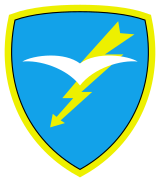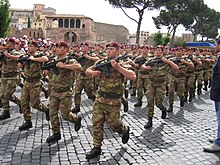
The 9th Paratroopers Assault Regiment "Col Moschin" is an active Special Forces unit of the Italian Army based in Livorno in Tuscany. The regiment is part of the Italian Army's infantry arm's Paracadutisti speciality and assigned to the Army Special Forces Command for training, preparation, doctrinal and procedural development, and the materiel acquisition. Operationally the regiment falls under the Italian Armed Forces' Joint Special Forces Operations Command. The regiment is the only military unit, which has participated in all out-of-area missions of the Italian Army since World War II.

The Paracadutisti are a speciality of the Italian army's infantry corps.
The article provides an overview of the entire chain of command and organization of the Italian Army after the reform of 1 May 2024 and includes all active units as of 1 May 2024. The Armed Forces of Italy are under the command of the Italian Supreme Defense Council, presided over by the President of the Italian Republic. The Italian Army is commanded by the Chief of the Army General Staff or "Capo di Stato Maggiore dell’Esercito" in Rome.
185th Paratroopers Division "Folgore" was an airborne division of the Royal Italian Army during World War II. The division was formed in Tarquinia near Rome on 1 September 1941. In July 1942 the division was sent to Libya to fight in the Western Desert Campaign and was destroyed during the Second Battle of El Alamein in early November 1942.
The 184th Paratroopers Division "Nembo" was an airborne division of the Royal Italian Army during World War II. After the Armistice of Cassibile the division joined the Italian Co-belligerent Army's Italian Liberation Corps and together with the Polish II Corps liberated Ancona in the Battle of Ancona.
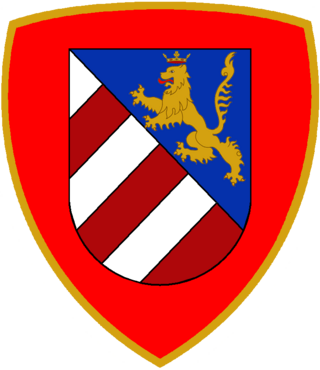
The Mechanized Brigade "Gorizia" was a mechanized brigade of the Italian Army. Its core units were mechanized infantry battalions. The brigade's headquarters was in the city of Gorizia and the brigade's units were based in the region of Friuli-Venezia Giulia. The brigade's name was chosen in memory of the World War I Battle of Gorizia. The brigade's sister brigade, the Armored Brigade "Vittorio Veneto", was named to commemorate the World War I Battle of Vittorio Veneto.

The Mechanized Division "Folgore" was a mechanized division of the Italian Army. Its core units were three mechanized brigades. The brigades headquarters was in the city of Treviso.
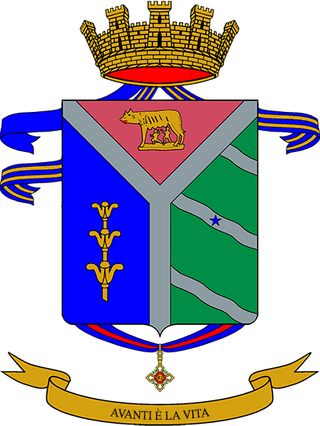
The 8th Paratroopers Engineer Regiment "Folgore" is the Italian Army's airborne combat engineer unit. The regiment provides close combat support to the Paratroopers Brigade "Folgore".

The 185th Paratroopers Artillery Regiment "Folgore is an artillery regiment of the Italian Army, specializing in airborne operations. Originally an artillery regiment of the Royal Italian Army, the regiment was assigned in World War II to the 185th Infantry Division "Folgore", with which the regiment was deployed to North Africa for the Western Desert campaign, during which division and regiment were destroyed in the Second Battle of El Alamein. Reformed in 1975 the regiment is today based in Bracciano near Rome and assigned to the Paratroopers Brigade "Folgore". The regimental anniversary falls, as for all Italian Army artillery regiments, on June 15, the beginning of the Second Battle of the Piave River in 1918.
The Italian Liberation Corps was a corps of the Italian Co-belligerent Army during the Italian campaign of World War II. After the announcement of the Armistice of Cassibile on 8 September 1943 the Italian government began the formation of units to fight on the allied side against Germany. On 18 April 1944 the Italian Liberation Corps was formed, which after an intense cycle of combat operations was disbanded on 24 September 1944 to form division-sized combat groups.

The 185th Paratroopers Reconnaissance Target Acquisition Regiment "Folgore" is an Italian Army special forces unit. The regiment is part of the Italian Army's infantry arm's Paracadutisti speciality and assigned to the Army Special Forces Command.
With the 1975 reforms the Italian Army abolished the regimental level and replaced it with brigades made up of multiple arms. During the reform the army disbanded 48 regimental commands and reduced its force by 87 battalions. A further ten regimental commands were used to raise ten new brigade commands. Ten training centers, which for traditional reasons had carried the names of regiments, were also disbanded. The reduction in units also allowed to mechanize most of the remaining units in Northern Italy and Italy's defense strategy changed from a hold-at-all-costs territorial defense to one of mobile warfare.

The 183rd Paratroopers Regiment "Nembo" is an active unit of the Italian Army based in Pistoia in Tuscany. The regiment is part of the Italian Army's infantry arm's Paracadutisti speciality and assigned to the Paratroopers Brigade "Folgore".

The 186th Paratroopers Regiment "Folgore" is an active unit of the Italian Army based in Siena in Tuscany. The regiment is part of the Italian Army's infantry arm's Paracadutisti speciality and assigned to the Paratroopers Brigade "Folgore".

The 187th Paratroopers Regiment "Folgore" is an active unit of the Italian Army based in Livorno in Tuscany. The regiment is part of the Italian Army's infantry arm's Paracadutisti speciality and assigned to the Paratroopers Brigade "Folgore".

The 182nd Armored Infantry Regiment "Garibaldi" is an inactive unit of the Italian Army last based in Sacile in Friuli-Venezia Giulia. The regiment was part of the Italian Army's infantry arm and was last assigned to the Infantry Division "Folgore".
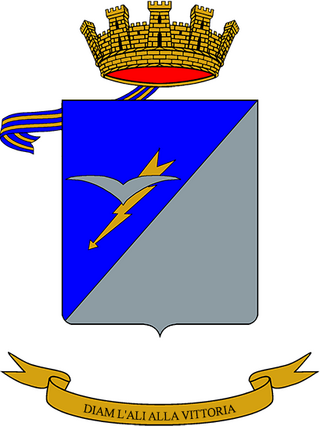
The Logistic Regiment "Folgore" is a military logistics regiment of the Italian Army based in Pisa in Tuscany. Today the regiment is the logistic unit of the Paratroopers Brigade "Folgore". The regimental anniversary falls, as for all units of the Transport and Materiel Corps, on 22 May, the anniversary of the Italian Army's first major automobile use to transport reinforcements to counter the Austro-Hungarian Offensive at Asiago in 1916.

The 6th General Support Logistic Regiment is a military logistics regiment of the Italian Army based in Budrio in the Emilia Romagna. The regiment is assigned to the Logistic Support Command and manages the transport of equipment, personnel, and materiel from the logistic transit areas to military units in operations. The 6th regiment, together with the Transit Areas Management Regiment provides third line logistic support for the army's brigades and Rapid Deployable Corps – Italy. The regimental anniversary falls, as for all units of the Transport and Materiel Corps, on 22 May, the anniversary of the Italian Army's first major automobile use to transport reinforcements to counter the Austro-Hungarian Offensive at Asiago in 1916.
The 184th Paratroopers Regiment "Nembo" is a unit of the Italian Army based in Livorno in Tuscany. Formed in 1942 and active during World War II the regiment is part of the army's infantry arm's Paracadutisti speciality. On 4 October 2022 the regiment's name, flag, and traditions were assigned to the Command and Tactical Supports Unit "Folgore" of the Paratroopers Brigade "Folgore".
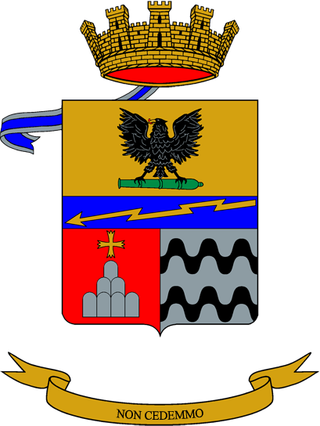
The 184th Artillery Regiment "Nembo" is an inactive field artillery regiment of the Italian Army, which was based in Gradisca d'Isonzo in Friuli-Venezia Giulia. Originally an artillery regiment of the Royal Italian Army, the regiment was assigned in World War II to the 184th Infantry Division "Nembo", which was Italy's second paratroopers divisions. After the announcement of the Armistice of Cassibile the division and regiment joined the Italian Liberation Corps and fought on the allied side in the Italian campaign. In 1944 the regiment joined the Combat Group "Folgore" of the Italian Co-belligerent Army and was assigned to the British XIII Corps. During the Cold War the regiment was assigned to the Infantry Division "Folgore" and from 1976 the Mechanized Division "Folgore". The regiment was disbanded in 1996. The regimental anniversary falls, as for all Italian Army artillery regiments, on June 15, the beginning of the Second Battle of the Piave River in 1918.
